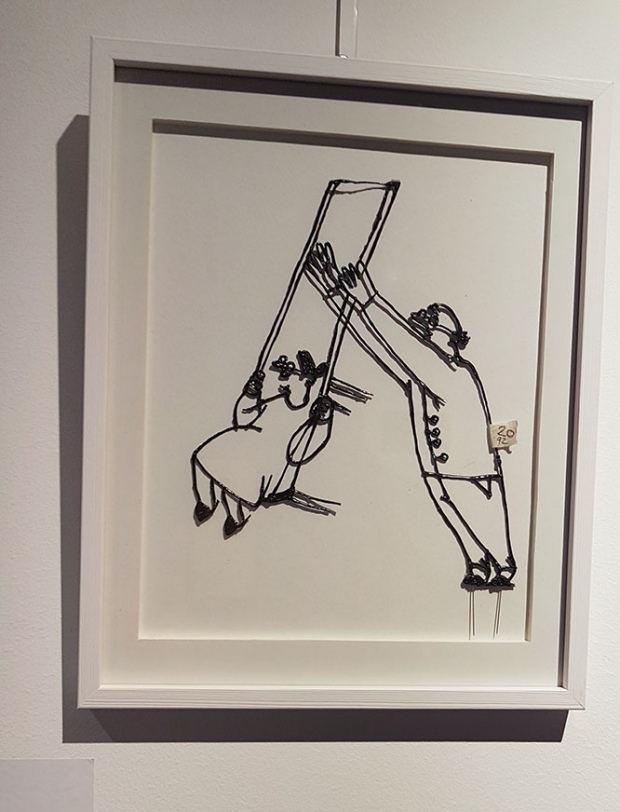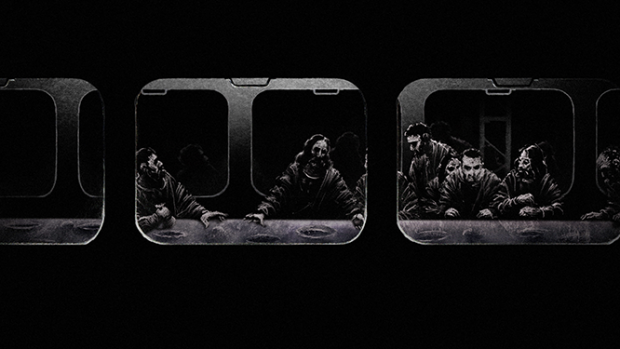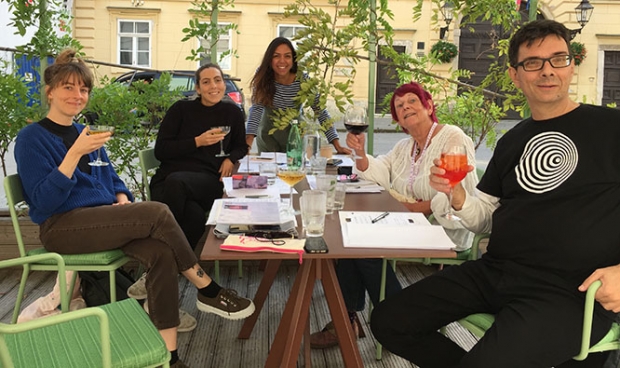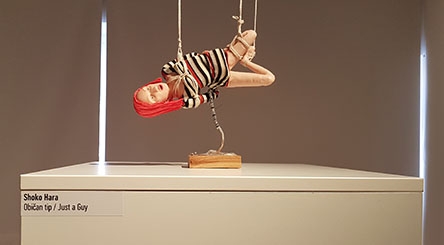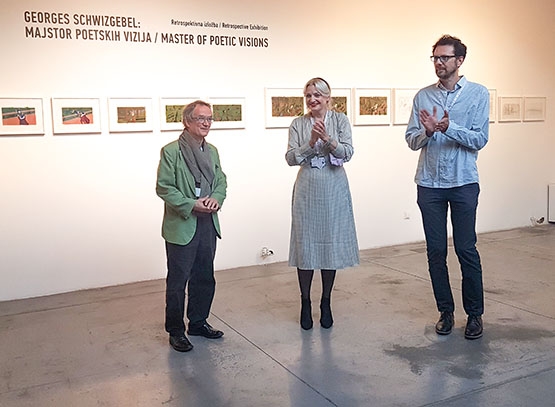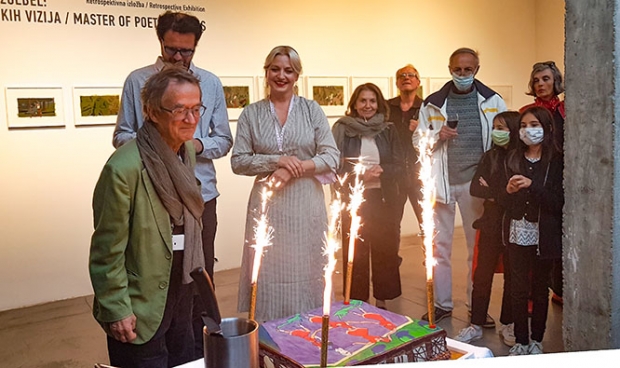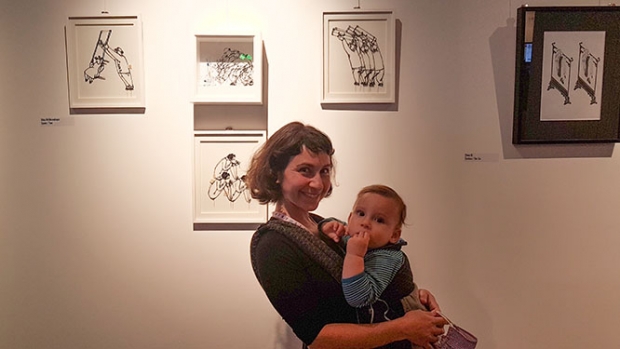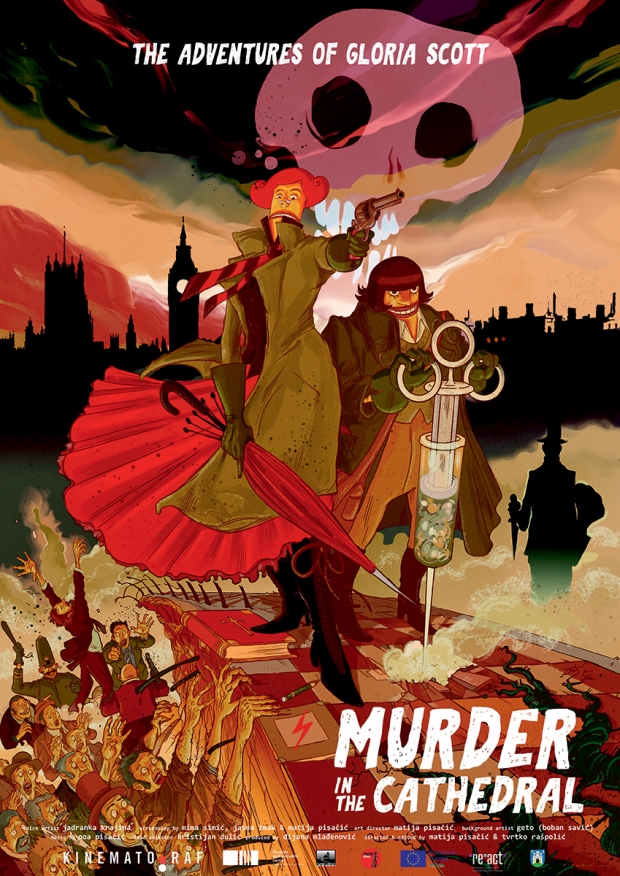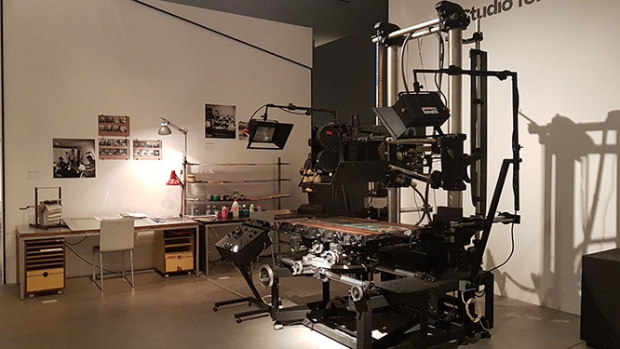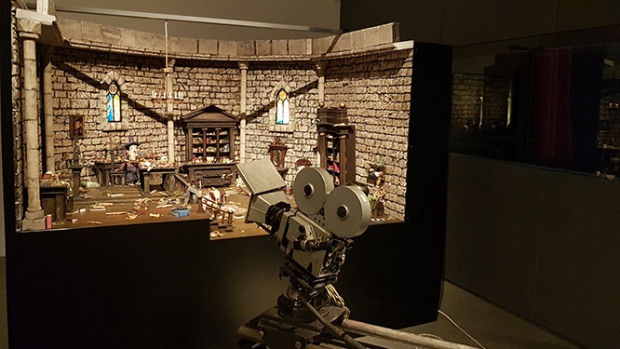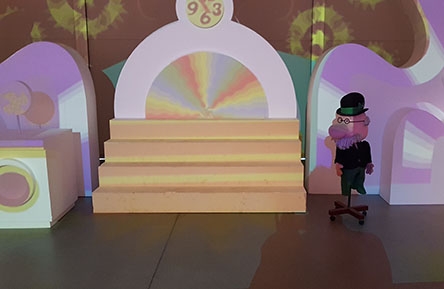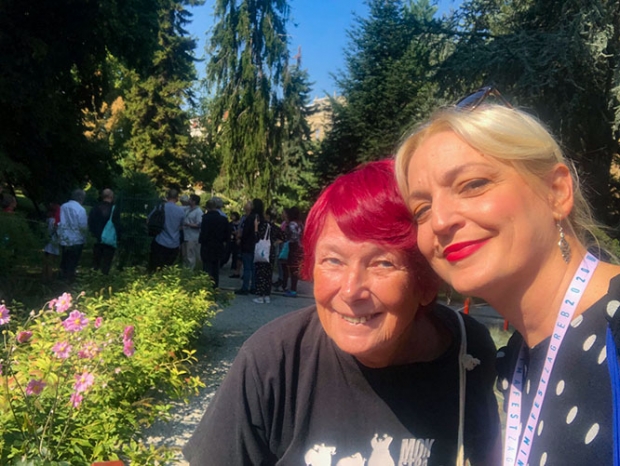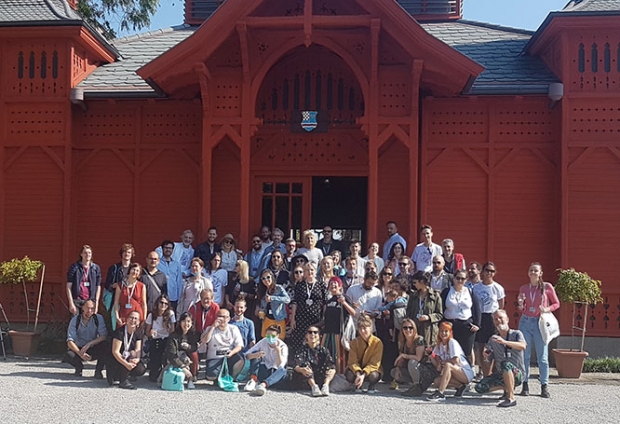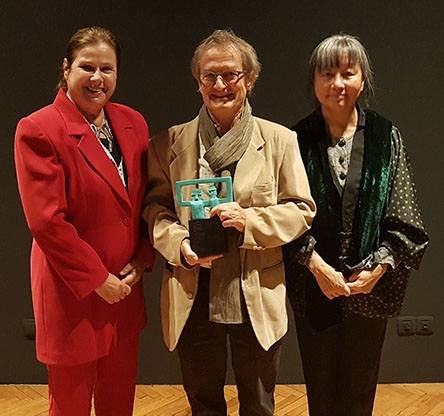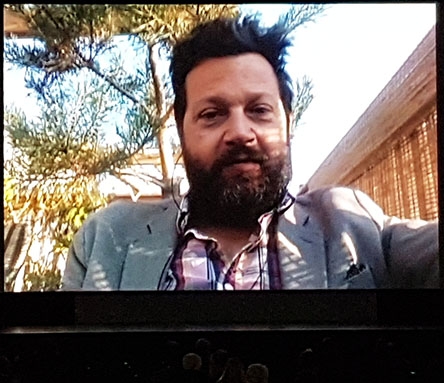This year against all odds I found myself in Zagreb, and not just there, but on the Grand Competition International Jury.
This year against all odds I found myself in Zagreb, and not just there, but on the Grand Competition International Jury. When the invitation came to participate in the festival, I just couldn’t turn it down; Animafest is one of my favorite festivals every year. I knew that the organizers would take every precaution to keep us safe, and they did - along with providing hand gel at the entrance, every person’s temperature was taken before entering either of the two theatres.
This year’s film selection was extremely strong with well put together programs. One of my favorite films was Ties by the Russian animator Dina Velikovskaya. The film is a personal story about leaving home for the first time using a unique animation technique. It is the first animated film made entirely with a 3Doodler pen and wire. The story of a young girl who wants to go out into the world and how it almost causes her parents' lives to unravel is a story everyone can relate to. It came out of Dina’s move to Germany, leaving her parents behind in Russia. The film looks beautiful and the story is so touching that I am sure Ties will be as big a hit as her two previous films, About A Mother (2015) and Kukuschka (2016).
Piotr Dumala’s films are often dark and upsetting but never boring. The Polish animator has a true genius for telling powerful stories without a word spoken. His 2000 Crime and Punishment goes right to the heart of the unconscious mind of a killer in this tale of love and obsession without a single word being uttered.
In 2014 Dumala created Hipopotamy. Although I have seen this film many times, its impact has not lessened for me; this unsettling film about male violence still makes me angry. His latest film Last Supper also has an unexpected and chilling twist at the end that left me thinking about it long after the last frame of the film. In Piotr’s contemporary take on one of the most famous artworks in the world, Leonardo Da Vinci’s Last Supper, Jesus and the twelve apostles are seated at a table on a train. It is dark outside and the men are moving to the rhythm of a string quartet. The beautiful piece of music was composed by Sebastian Ladyzynski. The apostles vanish one by one until you just see Jesus and Judas Iscariot clutching a bag with his thirty pieces of silver. After Judas disappears, leaving Jesus on the train, the viewer suddenly realizes where the train is going.
There were so many excellent films this year that could have easily won the Grand Prix. The Grand Competition jury had tough decisions to make. The jury was composed of programmer Clemence Bragard from France, Hungarian animator Reka Bucsi, Zagreb media artist and director Vladislav Knezevic, Italian animator Martina Scarpelli, and me.
After extensive discussion, we decided to award the Grand Prix to Shoko Hara for Just a Guy. The animated documentary is about women who fall in love with serial killers on death row. This is a very real phenomenon. The film focuses on three women, including Hara herself, who wrote to the notorious serial killer Richard Ramirez, known as The Night Stalker while he was on death row in San Quentin prison. From June 1984 to August 1985 Ramirez drove up and down the freeway from Los Angeles to San Francisco randomly breaking into homes, killing at least fourteen people of both sexes, raping and torturing at least two dozen more. The film focuses on the women who fall in love with death row convicts and is not about the crimes or the murderers themselves.
After Ramirez was sentenced to death, he had an enormous number of female groupies and one woman actually married him. The film focuses on two women, the Death Rock star Eva O. and Shoko Hara’s friend Sarah. Shoko was convinced to write to Ramirez once out of curiosity and naivety by Sarah, who was sexually obsessed with Ramirez. After he wrote her back, Shoko realized she had made a mistake. The film doesn’t point a finger at all of the women who wrote to him but tries to understand what motivated them to want to write to him.
The title, Just a Guy, comes from how Ramirez referred to himself. The fifteen-minute film uses collage, archival footage and Claymation. Shoko explained “To emphasis the different layers of subjectivity, we used different animation techniques. I chose Claymation for the past, when the protagonists talk about their memories, to visualize that memories are not clean but smeared, milky, and reduced to the essentials. Clay enables (the animator) to squeeze or stretch the object unlike rigid stop-motion objects or puppets and it also looks like wet skin which I really liked and found a bit ugly as well. The puppets . . . were used for the present and therefore have a certain realism”.
The director has also put together a small paperback book with reproductions of the actual letters in Ramirez’s handwriting that he sent to Sarah and Eva O. There is also a reproduction of the one letter Shoko received but never answered. They make for chilling reading. The documentary and letters were particularly interesting to me because I was living in San Francisco at the time of the murders and I remember the fear that gripped the city until he was apprehended. He committed one double murder of an elderly couple just a few blocks from my house.
A special program paid tribute to Pavao Stalter, one of the masters of the famous Zagreb School of Animation. Eight films were shown from this prolific animator’s long career which spanned from 1958 to 2015. Included in the program is my favorite among Pavao’s films, The Fifth One.
In the 2 ½ minute film four members of a string quartet play together in harmony and repeatedly reject a fifth player who tries to join in with his tuba. After several attempts of trying to play with them, the tuba player is taken off the screen and a shot is heard. The quartet begins to play again, then the tuba player returns with a bandage on the front of his hat. He starts to play his bass notes and the other members of the quartet join in to his beat, giving up and bowing to the inevitable. The film is a metaphor for persistence leading to social change.
At a special presentation twin brothers Milivoj and Veljko Popovic presented three new projects that they and their crew at Prime Render Studio in Split, Croatia are working on. The first is an animated feature film titled Snovozemlje (Dreamworld). The movie is still in the scripting stage and scriptwriter Pedro Rivero joined the brothers on stage. Pedro is known for his direction of such classic films as the animated feature Psiconautus, the Forgotten Children and the Goya Award-winning Birdboy. He also co-wrote the screenplay for the live-action Spanish hit film The Platform which can currently be seen on Netflix. I am looking forward to seeing what Pedro and the Popovic Brothers come up with, it is bound to be interesting.
The brothers then went on to present their animated VR project Dislocation. In the project when you put on the glasses you become a refugee fleeing from war, poverty, or any of the other tragic situations that force someone to leave their homeland. They also talked about the challenges of turning an animated VR installation into a classic animated film. While at Animafest the Poovic’s received the exciting news that Dislocation had received the award for best VR film at the Ottawa International Animation Festival.
The final project is a 2D animated film which is an adaption of the eponymous book by Split author Tisja Kljakovic Braic. This project is in the very earliest stages with no release date as of yet projected.
Prime Render, formerly named Lemonade, is a multi-award winning studio that has created such films as She Who Measures, Planemo, and the multi-award winning Cyclists which won Best Croatian Film at Animafest in 2018 and was a Vimeo Staff Pick. 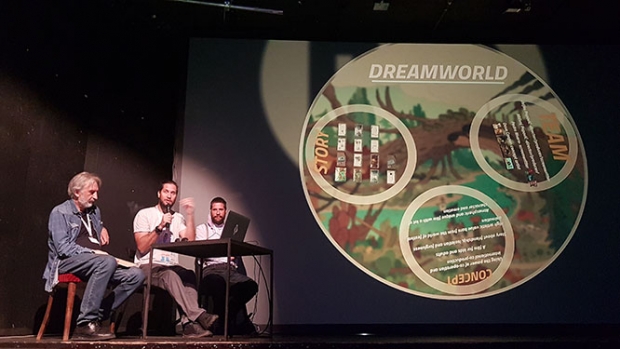
WTF Annecy was one of the most fun screenings this year. The weird, wacky, violent, and/or politically incorrect films were put together by Sebastien Sperer, a member of the Annecy Film and Programing team. WTF was part of Animafest’s salute to Annecy’s 60th Anniversary this year. It included such gems as Farce which is described in the catalogue as a man, a woman, and a meat grinder”. In the Norwegian film by Robin Jensen a reindeer herder has his herd stolen along with the woman he loves. He gives chase and accidentally ends up amidst the thieves in the big city where he discovers a world where meat from questionable sources is served in a restaurant while rape porn is produced in the basement.
It is interesting to note that Obverse and Reverse was the only film in the WFT program made by a woman. The eight-minute film was created by Barbara Rupik, a student at the Polish National Film School in Lodz. She describes her film as “The other side of a picture that hides a parallel world. The two worlds are constantly intertwining and interacting with each other”. That sounds harmless enough but there was plenty of blood and gore. The salute to all things gory and gross was held at night in the outdoor bar which meant that there was plenty of beer and wine to help the gore go down smoothly.
One of the highlights of Animafest every year is an excellent exhibition curated by Paola Orlic. The Master of Poetic Visions retrospective at the Kranjcar Gallery paid tribute to this year’s Life Time Achievement Award winner Georges Schwizgebel. In a career that spans nearly half a century, he has created nineteen films. He still sticks to the technique that he used to create his first film The Flight of Icarus (1974) using paint on foil, which he often combines with pastels, gouache, acrylics, or cutouts.
When asked what are the main influences on his work, he immediately said music first, then movement and image, and then narrative at the end. When you watch his beautifully crafted films it is evident that classical music is his great inspiration, replacing dialogue in his animations with music. He has said that “I enjoy expressing myself without dialogue. It is a means of communication accessible to all. Although Georges does not play any instruments himself, his son, Louis Schwizgebel-Wang, is an award-winning classical pianist. In 2011 Louis performed the music along with his sister Tina on the cello for Georges's film Romance. For the 2015 film Erlking, Louis also played the Schubert and Liszt score.
The exhibition consisted of sixty paintings, drawings, and sketches selected by Georges as the most representative examples of his work. Thirty-four were images from 13 different films while the remaining paintings and sketches were from Erlking. The official opening of the exhibition coincided with Georges’ birthday and there he was surprised and honored with a large birthday cake from the festival.
Last year the festival inaugurated a Behind the Scenes exhibition, a making-of group exhibition of works from films in the Grand Competition Short Film Screenings. Each of the twelve participants could contribute up to five pieces from their film which provided a broad selection of artwork. They ranged from classical paintings, sketches, drawings, prints, puppets, and set parts to installations, and multimedia presentations.
I was particularly happy to see artwork from The Adventures of Gloria Scott – Murder in The Cathedral. The film is set in early 20th century London where the ‘’famous’’ detective Gloria Scott and her faithful companion Mary Lambert are spending a quiet evening in their office. Then, an unknown murderer kills Professor Janson on their doorstep. A new adventure awaits them as they search for the murder, including a visit to a Chinese restaurant, a cathedral, a wax museum, and the discovery of a great conspiracy.
These female versions of Sherlock Holmes and Doctor Watson were created by Croatian writer Mima Aimi, who along with Croatian screenwriter Jasna Jasna Zmak wrote the screenplay. Directors Maija Pisacic and Tvrtko Raspolic have developed the characters into a beautifully designed film and Gloria and Mary made me laugh every time I looked at them. Visually the backgrounds are full of interesting details and beautifully executed. There are also some very funny in-jokes. The Adventures of Gloria Scott is the title of a Sherlock Holmes adventure by Sir Arthur Conan Doyle. In Doyle’s story, the Gloria Scott is a ship bound for Australia that blows up. Murder in the Cathedral is the title of T. S. Eliot’s verse dramatization of the murder of Archbishop Thomas Becket in Canterbury Cathedral in 1170. Pisacic and Raspolic created Murder in the Cathedral as a pilot project for a series, and I hope that they succeed because I would love to see more of the two ladies’ adventures.
Augmented Reality App, a group exhibition by students of the Zagreb Academy of Fine Arts, was sponsored and created in collaboration with the digital agency Masinerija. It was implemented as part of the first-year course Multimedia Exercises and Techniques in Animated Film in the graduate program of animation, taught by artistic director Daniel Suljic. To see the seven short animated projects, you looked for the stickers with the illustrations located around the festival site, scanned the QR code and downloaded the app.
I was fortunate enough to visit the Museum of Contemporary Art Zagreb to see the Imagination to Animation: Six Decades of Zagreb Film exhibition. The multimedia exhibition is dedicated to works created by animators working in the famous Croatian film company, founded in 1953. In the nearly seven decades of its existence, the studio has produced more than two thousand animated, documentary, educational, and feature films as well as commercials. The studio is also the birthplace of what has come to be known as the Zagreb School of Animation that has won more than 500 awards. Most notable of these is the Academy Award won by Dusan Vukotic in 1962 for his film Ersatz (Surogat). This was followed by three other Oscar nominations: The Game (Igra) by Dusan Vukotic (1964), Tup-Tup by Nedeljko Dragic, (1973) and finally in 1980 Dream Doll (Lutka Snova) directed by Zlatko Grgic and Bob Godfrey. The renowned studio also garnered numerous awards from local and European film and animation festivals.
Along with presenting a selection of films, the exhibition contains drawings, sketches, and cels from The Studio for Animated Film which was founded in 1956 as part of Zagreb Film. They also have original equipment from the studio such as a complete camera, ink and paint station, and a camera dolly.
A thank you goes to Museum of Contemporary Art Zagreb Director Snjezana Pintaric and exhibition curator Vesna Mestric who gave Danial, Nik and I a personal guided tour of the exhibition. If you are in Zagreb in the near future I suggest that you go see this wonderful exhibition.
Unfortunately, due to the restrictions of social distancing this year, the festival could not put the guests on a bus to drive us an hour outside of the city for the traditional picnic. The creative festival staff came up with a lovely alternative. As a group, we walked the few blocks from our hotel to the Zagreb Botanical Garden where we were met at the entrance by a docent who took us on a tour of the beautiful gardens. Being avid gardeners, Nik and I were especially delighted to have the opportunity to see some of the 10,000 species of plants on display. I also learned that Croatia is one of the richest European countries in biodiversity. The garden was founded in 1889 and covers five hectares.
Our tour ended at the recently restored Red Pavilion where a delicious picnic awaited us. The botanical garden was the perfect place for relaxed conversations over food and drinks. Music was provided by Velko and Milivo Popovic and Nik.
When planning the festival, the organizers, artistic director Daniel Suljic, along with festival producers Matea Milic and Paola Orlic not only had to contend with the pandemic but also had to deal with both an earthquake and a flood. The earthquake damaged the original festival site in March and a new location had to be found, so there were definitely changes in the works.
The new location, The University of Zagreb Student Center, had some advantages as well as some drawbacks. Unlike past years when events were held in different locations, all screenings could be held in one place because there are two theatres at the student center. Among the drawbacks is that it is located a bit away from the center of town and, although the student center has a bar with a very nice and efficient bartender, there aren’t any restaurants nearby.
Animafest Scanners Symposium, held in conjunction with the festival annually, was entirely online this year. Scanners brings together filmmakers and scholars to examine theoretical and practical approaches to animation. The sixteen speakers at the 7th edition delivered papers on three topics: Animation in the World of Chaos, Women in Animation, and Animation and Poetry. The keynote address was delivered by Chris Robinson, Canadian animation researcher and Artistic Director of the Ottawa International Animation Festival. Chris was also the recipient of this year’s Animafest Zagreb Award for Outstanding Contributions to Animation Studies.
One thing that remained unchanged was the quality and number of films, over 300 of them! The festival got off to a rousing start with the opening night ceremony. After we were welcomed by Milana Vukovic, Head of the City Department of Culture of the City of Zagreb; Peter Marcich, Head of the Croatian Audiovisual Center; and Daniel Suljic, Marta Milic and Paola Orlic, the Animafest Lifetime Achievement Award was presented to the renowned Swiss animator Georges Schwizgebel, who was on hand to receive his award in person. The recipient of the Lifetime Achievement Award is selected each year by the Animafest Council. Presenting the award to Georges was Margit Antauer, President of the Council. Margit, better known as Buba, noted that he is the most awarded animator in the festival’s history with seven awards and three special mentions.
Chris Robinson accepted his award for Outstanding Contributions to Animation Studies via the internet. The award for The Best Animation School this year went to the Polish School of Film, Television, and Theatre in Lodz.
The special presentations were followed by a screening of the first International Competition program. My belief that Daniel Suljic is one of the best animation programmers was once again born out
The week literally flew by and all too soon it was closing night. Following the closing ceremony, we all went to the Arts and Crafts Museum where we danced until the wee hours of the morning.
I had such a wonderful week at Animafest. After being locked down for so long it was great to be watching film on a proper screen in a theatre with lots of friends. A special thank you goes to our jury minder Matilda Fatur, who made sure that we were in the right place at the right time and always seemed to know when I needed a glass of red wine. A very big thank you goes to Daniel Suljic, Paolo Orlic, and Matea Milic for inviting me to be a member of the jury and treating me like royalty. Last but not least, a thank you goes to the numerous volunteers who were always on hand and eager to answer questions or help in any way that they could. Now I am at home again in lockdown and it looks like I will be for the foreseeable future but it is lovely to memories of my week in Zagreb to get me through these dark days.
Next year the festival will take place from 7 to 12 June. I am already looking forward to being there. You can find out more about this year’s festival and how to submit your film at: Animafest.hr
THE JURY RESULTS
Short Film Jury: Clemence Bragard, Reka Bucsi, Nancy Denney-Phelps, Vladislav Knezevic and Martina Scarpelli
- Grand Prix – Just a Boy, Shoko Hara, Germany
- Golden Zagreb Award for Creativity and innovative achievement – Freeze Frame, Soetkin Verstegen, Belgium and Germany
The Zlatko Grgic Award for the best first film – Symbioss, Nadja Andrasev, France and Hungary
Special Mentions
- Clemence Bragard – How To Disappear, Robin Klengel, Leonhard Mullner and Michael Stumpf, Austria
- Reka Bucsi – My Exercise, Atsushi Wada, Japan
- Nancy Denney-Phelps – The Physics of Sorrow, Theodore Ushev, Canada
- Vladislav Knezevic –Pulsion, Pedro Casavecchia, Argentina and France
- Martina Scarpelli – Betty, Will Anderson, United Kingdom
Student and Croatian Film Competition Jury: Laurent Crouzeix, Hefang Wei, and Mladen Dukic
Dusan Vukotic Award for best student film – Naked, Kirill Khachatrov, Russia
- Special Mention – Pearl Diver, Margrethe Danielsen, Norway
- Special Mention – Airhead, Gaspar Chabuad, Belgium
- Special Mention – Survival HK, Louise Pau, Hing Kong and USA
Best Croatian Film – Arka, Natko Stipanicev
- Special Mention – All Those Sensations in my Belly, Marko Djeska
Children’s Competition Jury: Una Patafta, Maris Popovic, Din Hodzovic, Sio Varosanec, and Ruta Popovc
Best Children’s Film – Daughter, Daria Kashcheeva, Czech Republic
- Special Mention – MareMonstrum, Angel Estois, Lucia Hernanez, and Merce Sendino, Spa
Mr. M Audience Award – The Physics of Sorrow, Theodore Ushev, Canada

